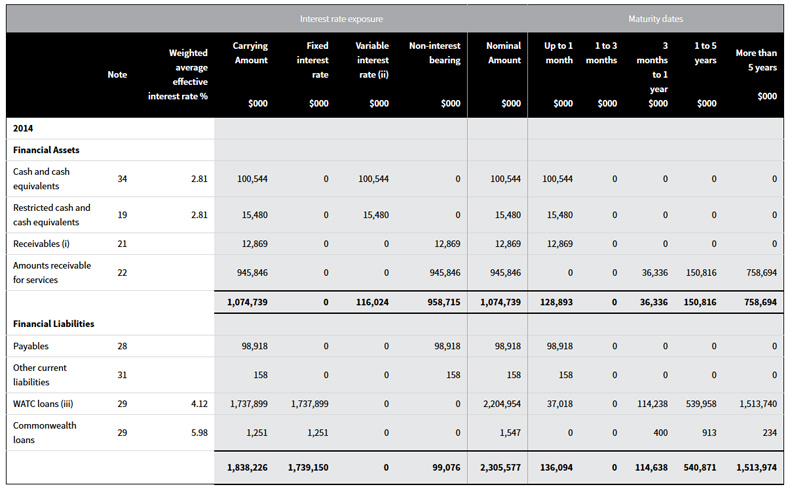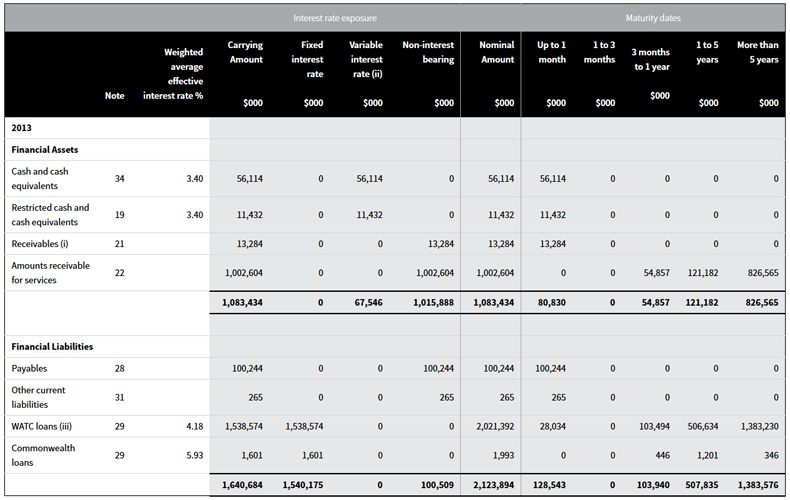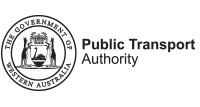- Home
- Financials
- Notes to the financial statements
- Financial Instruments
Financial Instruments
a) Financial risk management objectives and policies
Financial instruments held by the PTA are cash and cash equivalents, restricted cash and cash equivalents, WATC borrowings, finance leases, receivables and payables. The PTA has limited exposure to financial risks. The PTA's overall risk management program focuses on managing the risks identified below.
Credit risk
Credit risk arises when there is the possibility of the PTA's receivables defaulting on their contractual obligations resulting in financial loss to the PTA.
The maximum exposure to credit risk at end of the reporting period in relation to each class of recognised financial assets is the gross carrying amount of those assets inclusive of any provisions for impairment as shown in the table at note 38 'Financial instruments disclosures' and note 21 'Receivables'.
Credit risk associated with the PTA's financial assets is minimal because the main receivable is the amounts receivable for services (holding account). For receivables other than government, the PTA trades only with recognised, creditworthy third parties. The PTA has policies in place to ensure that sales of products and services are made to customers with an appropriate credit history. In addition, receivable balances are monitored on an ongoing basis with the result that the PTA's exposure to bad debts is minimal. At the end of the reporting period there are no significant concentrations of credit risk.
Liquidity risk
Liquidity risk arises when the PTA is unable to meet its financial obligations as they fall due.
The PTA is exposed to liquidity risk through its trading in the normal course of business. The PTA has appropriate procedures to manage cash flows including drawdowns of appropriations by monitoring forecast cash flows to ensure that sufficient funds are available to meet its commitments.
The PTA has a short-term liquidity facility of $200 million on which it can draw down to fund temporary cash shortfall. The PTA is currently in a net current liability position but can convert its short term borrowings at any time as approval from the Western Australian.
Treasury Corporation (WATC) has been obtained. As such, this does not pose a liquidity risk to the PTA.
Market risk
Market risk is the risk that changes in market prices such as foreign exchange rates and interest rates will affect the PTA's income or the value of its holdings of financial instruments.
The PTA's exposure to market risk for changes in interest relates primarily to the long-term debt obligations. The PTA's borrowings are all obtained through WATC and are repayable at fixed rates with varying maturities. The risk is managed by WATC through portfolio diversification and variation in maturity dates. The PTA earns interest on the daily balance of its bank account.
The PTA does not trade significantly in foreign currency and is not materially exposed to other price risks.
b) Categories of Financial Instruments
The carrying amounts of each of the following categories of financial assets and financial liabilities at the end of reporting period are:
| 2014 $000 |
2013 $000 |
|
|---|---|---|
| Financial Assets | ||
| Cash and cash equivalents | 100,544 | 56,114 |
| Restricted cash and cash equivalents | 15,480 | 11,432 |
| Loans and receivables (i) | 958,715 | 1,015,888 |
| Financial Liabilities | ||
| Financial Liabilities measured at amortised cost | 1,838,226 | 1,640,684 |
(i) The amount of loans and receivables excludes GST recoverable from ATO (statutory receivable) and prepayments.
c) Financial Instrument Disclosures
Credit risk
The following table discloses the PTA’s maximum exposure to credit risk and the ageing analysis of financial assets. The PTA’s maximum exposure to credit risk at the end of reporting period is the carrying amount of the financial assets as shown below. The table discloses the ageing of financial asset that are past due but not impaired and impaired financial assets. The table is based on information provided to senior management of the PTA.
The PTA does not hold any collateral as security or other credit enhancement relating to the financial assets it holds.
Ageing analysis of financial assets
| Past due but not impaired | |||||||||
|---|---|---|---|---|---|---|---|---|---|
Note |
Carrying Amount $000 |
Not past due and not impaired $000 |
Up to 1 month $000 |
1 to 3 months $000 |
3 months to 1 year $000 |
1 to 5 years $000 |
More than 5 years $000 |
Impaired financial assets $000 |
|
| 2014 | |||||||||
| Cash and cash equivalents | 34 | 100,544 | 100,544 | 0 | 0 | 0 | 0 | 0 | 0 |
| Restricted cash and cash equivalents | 19 | 15,480 | 15,480 | 0 | 0 | 0 | 0 | 0 | 0 |
| Receivables (i) | 21 | 12,869 | 8,959 | 2,686 | 1,076 | 148 | 0 | 0 | 0 |
| Amounts receivable for services | 22 | 945,846 | 945,846 | 0 | 0 | 0 | 0 | 0 | 0 |
| 1,074,739 | 1,070,829 | 2,686 | 1,076 | 148 | 0 | 0 | 0 | ||
| 2013 | |||||||||
| Cash and cash equivalents | 34 | 56,114 | 56,114 | 0 | 0 | 0 | 0 | 0 | 0 |
| Restricted cash and cash equivalents | 19 | 11,432 | 11,432 | 0 | 0 | 0 | 0 | 0 | 0 |
| Receivables (i) | 21 | 13,284 | 9,345 | 2,087 | 1,667 | 0 | 0 | 0 | 185 (ii) |
| Amounts receivable for services | 22 | 1,002,604 | 1,002,604 | 0 | 0 | 0 | 0 | 0 | 0 |
| 1,083,434 | 1,079,495 | 2,087 | 1,667 | 0 | 0 | 0 | 185 | ||
(i) The amount of receivables excludes GST recoverable from ATO (statutory receivable) and prepayments.
(ii) The carrying amount of the receivable before deducting the impairment was $492,000 in 2013. It is expected that $185,000 of the amount owing will be recovered.
Liquidity risk and interest rate exposure
The following table details the PTA’s interest rate exposure and the contractual maturity analysis of financial assets and financial liabilities. The maturity analysis section includes interest and principal cash flows. The interest rate exposure section analyses only the carrying amounts of each item.
Interest rate exposure and maturity analysis of financial assets and financial liabilities

(Click to enlarge table)
(i) The amount of receivables excludes GST recoverable from ATO (statutory receivable) and prepayments.
(ii) Variable interest rates represent the most recently determined rate applicable to the instrument at the end of reporting period.
(iii) The principal repayment of the WATC loans is based on a 25 year repayment schedule.

(Click to enlarge table)
(i) The amounts disclosed are the contractual undiscounted cash flows of each class of financial liabilities.
(ii) Variable interest rates represent the most recently determined rate applicable to the instrument at the end of reporting period.
(iii) The principal repayment of the WATC loans is based on a 25 year repayment schedule.
Interest rate sensitivity analysis
The following table represents a summary of the interest rate sensitivity of the PTA’s financial assets and liabilities at the end of the reporting period on the surplus for the period and equity for a 1% change in interest rates. It is assumed that the change in interest rates is held constant throughout the reporting period.
| -100 basis points | +100 basis points | ||||
|---|---|---|---|---|---|
| 2014 |
Carrying amount $000 |
Surplus $000 |
Equity $000 |
Surplus $000 |
Equity $000 |
| Financial Assets | |||||
| Cash and cash equivalents | 100,544 | (1,005) | (1,005) | 1,005 | 1,005 |
| Restricted cash and cash equivalents | 15,480 | (155) | (155) | 155 | 155 |
| Total increase/ (decrease) | (1,160) | (1,160) | 1,160 | 1,160 | |
| -100 basis points | +100 basis points | ||||
|---|---|---|---|---|---|
| 2013 |
Carrying amount $000 |
Surplus $000 |
Equity $000 |
Surplus $000 |
Equity $000 |
| Financial Assets | |||||
| Cash and cash equivalents | 56,114 | (561) | (561) | 561 | 561 |
| Restricted cash and cash equivalents | 11,432 | (114) | (114) | 114 | 114 |
| Total increase/ (decrease) | (675) | (675) | 675 | 675 | |
Fair Values
All financial assets and liabilities recognised in the Statement of Financial Position, whether they are carried at cost or fair value, are recognised at amounts that represent a reasonable approximation of fair value unless otherwise stated in the applicable notes.


